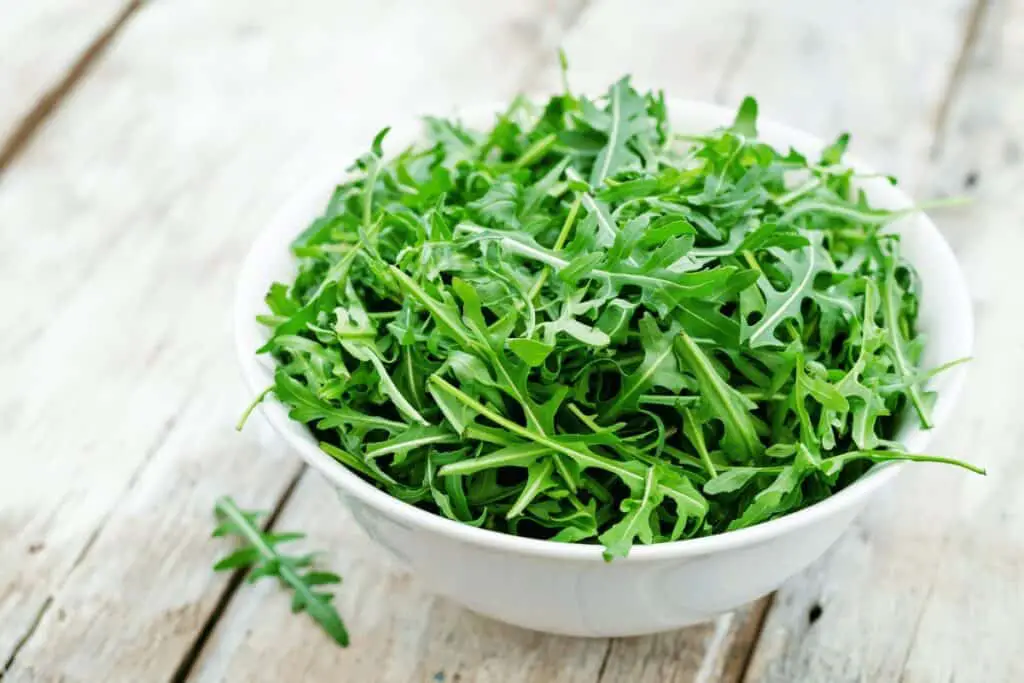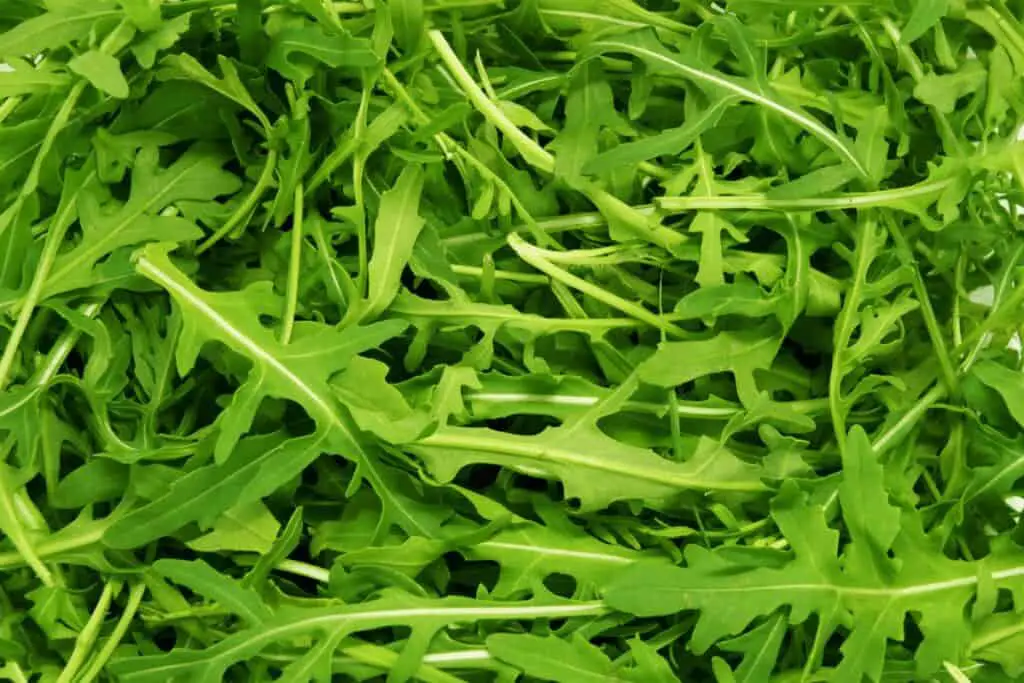Microgreens have gained popularity in recent years as a way to add a burst of flavor and nutrition to various dishes. Among the wide range of microgreens available, arugula microgreens stand out with their zesty and nutty flavor that complements many culinary creations. If you’re looking to start your journey in growing microgreens, arugula microgreens are an excellent choice, known for their quick growth and delightful taste.
In this article How to Grow Arugula Microgreens, we will guide you through the process of growing arugula microgreens, step by step, and provide you with valuable tips and insights to ensure a successful harvest.
Introduction How To Grow Arugula Microgreens
Arugula microgreens are the tender, young shoots of the arugula plant (Eruca sativa). They are harvested when the first true leaves appear, typically within 7 to 14 days after sowing the seeds. Arugula microgreens possess a concentrated flavor, packing a punch of peppery and nutty notes that add depth to salads, sandwiches, and other dishes.
Beyond their delicious taste, these microgreens are a nutritional powerhouse, containing high levels of vitamins A, C, and K, as well as important minerals like calcium and potassium [1].
What are Microgreens?

Before we delve into the specifics of growing arugula microgreens, let’s take a moment to understand what microgreens actually are. Microgreens are young, edible greens that are harvested at an early stage of growth, usually after the appearance of the first true leaves.
They are younger than baby greens but more mature than sprouts. Microgreens are known for their vibrant colors, diverse flavors, and concentrated nutritional profiles. They are prized by chefs and health-conscious individuals alike for their visual appeal and nutrient density [2].
Benefits of Arugula Microgreens
Arugula microgreens offer an array of benefits that make them a valuable addition to your diet. Here are some notable advantages:
- Rich in Nutrients: Arugula microgreens are packed with vitamins, minerals, and antioxidants, making them a nutritious choice for promoting overall health.
- Intense Flavor: The zesty, peppery taste of arugula microgreens adds a unique and vibrant flavor to a wide range of dishes, including salads, wraps, and soups.
- Quick Growth: Arugula microgreens are known for their rapid growth, usually ready for harvest within a week to ten days after sowing the seeds.
- Ease of Cultivation: These microgreens are relatively easy to grow, making them suitable for beginners and experienced gardeners alike.
- Space Efficiency: Arugula microgreens can be grown in small spaces, including containers, trays, or even on a windowsill, making them ideal for urban gardening or those with limited space.
Now that we understand the benefits of arugula microgreens, let’s explore the step-by-step process of growing them.
Growing Arugula Microgreens: Step-by-Step Guide

Choosing the Right Seeds
To start your arugula microgreens journey, you’ll need to acquire high-quality arugula seeds. Look for reputable seed suppliers or online stores specializing in microgreen seeds. It’s essential to choose seeds specifically labeled for microgreen production to ensure optimal results.
Preparing the Growing Container
Select a shallow tray or growing container with drainage holes to prevent waterlogging. Fill the container with a well-draining growing medium, such as potting soil or a pre-mixed microgreen growing mix. Spread the soil evenly and gently pat it down to create a smooth surface.
Sowing Arugula Seeds
Evenly sprinkle the arugula seeds over the soil surface in a single, dense layer. Aim for uniform coverage to ensure consistent growth. Gently press the seeds into the soil or use a fine mist sprayer to lightly moisten the seeds, aiding in their germination.
Providing Adequate Light and Water
Place the growing container in a well-lit area, preferably near a window where the microgreens can receive ample sunlight. If natural light is insufficient, consider using grow lights specifically designed for indoor gardening. Maintain a consistent temperature between 60°F and 75°F (15°C and 24°C) to promote optimal growth.
Keep the soil moist by lightly misting it with water once or twice a day, using a spray bottle. Avoid overwatering, as it can lead to mold or root rot. Within a few days, the arugula seeds will germinate, and the microgreens will begin to emerge.
Harvesting Arugula Microgreens
After about one week, the arugula microgreens will have developed their first true leaves, signaling that they are ready for harvest. Use a clean pair of scissors to cut the microgreens just above the soil level. Rinse them gently with water to remove any soil particles and pat them dry before incorporating them into your culinary creations.
Comparing Different Methods of Growing Arugula Microgreens
When it comes to growing arugula microgreens, you have a choice between two primary methods: soil-based and hydroponic. Let’s explore each method briefly:
Soil-Based Method
The soil-based method involves growing arugula microgreens in a growing medium such as potting soil or a specialized microgreen mix. It provides the microgreens with essential nutrients and a stable root environment. This method is relatively simple, affordable, and accessible to beginners.
Hydroponic Method
Hydroponic cultivation involves growing arugula microgreens without soil, using a nutrient-rich water solution as the growing medium. Hydroponics allows for precise control over nutrient levels and eliminates the risk of soil-borne diseases. However, it requires a more specialized setup and may be better suited for experienced gardeners or those with specific requirements.
Both methods can yield excellent results, so choose the one that aligns with your resources and preferences.
Common Mistakes to Avoid When Growing Arugula Microgreens
While growing arugula microgreens is relatively straightforward, there are a few common mistakes to avoid to ensure successful cultivation:
- Overwatering: Avoid excessive watering, as it can lead to mold growth or root rot. Maintain a lightly moist growing medium instead.
- Insufficient Light: Microgreens require ample light for proper growth. If natural light is limited, consider using grow lights to supplement.
- Crowded Planting: It’s important not to overcrowd the seeds when sowing. Overcrowding can hinder air circulation and lead to disease.
- Poor Ventilation: Ensure proper airflow around the growing microgreens to prevent the buildup of excess moisture or humidity.
- Neglecting Cleaning and Sanitization: Keep your growing containers, tools, and equipment clean to prevent the spread of pathogens or pests.
By avoiding these common mistakes, you can increase your chances of a successful arugula microgreens harvest.
Tips for Successful Arugula Microgreens Cultivation
To optimize your arugula microgreens cultivation, consider the following tips:
- Choose Organic Seeds: Opt for organic arugula seeds to ensure they are free from chemical treatments or genetic modifications.
- Rotate Crops: To avoid nutrient depletion and potential disease buildup, rotate the location where you grow your arugula microgreens.
- Experiment with Harvest Times: Harvest a portion of the microgreens at different stages to explore variations in flavor and texture.
- Add Microgreens to Established Plants: Use arugula microgreens to enhance the flavor and visual appeal of mature plants in your garden or indoor pots.
- Continuous Harvesting: For a continuous supply of fresh arugula microgreens, stagger your sowings, starting new batches every few days.
By implementing these tips, you can enhance the quality and quantity of your arugula microgreens harvest.
Ways to Use Arugula Microgreens in Your Recipes
Arugula microgreens can elevate the taste and visual appeal of various dishes. Here are a few ideas to incorporate them into your culinary creations:
- Salads: Sprinkle a handful of arugula microgreens on top of salads for a vibrant burst of flavor and a touch of elegance.
- Sandwiches and Wraps: Layer arugula microgreens in sandwiches and wraps to add a peppery kick and a refreshing crunch.
- Soups: Garnish soups, including vegetable or lentil soups, with a sprinkle of arugula microgreens for added texture and taste.
- Pasta Dishes: Toss cooked pasta with olive oil, garlic, and a generous handful of arugula microgreens for a simple yet delicious meal.
- Smoothies: Blend a small handful of arugula microgreens into your favorite smoothie recipe for an added nutritional boost.
The possibilities are endless, so get creative and explore different ways to incorporate arugula microgreens into your favorite recipes.
Conclusion How To Grow Arugula Microgreens
Growing arugula microgreens is a rewarding and straightforward process that allows you to enjoy the delicious and nutritious benefits of these vibrant greens. By following the step-by-step guide and implementing the tips provided, you can cultivate your own fresh and flavorful arugula microgreens right at home.
Experiment with different recipes and enjoy the burst of zesty flavor that arugula microgreens bring to your meals. Start your microgreens journey today and savor the joy of growing your own nutritious greens.
Frequently Asked Questions (FAQs)
Q: Can I reuse the soil after harvesting arugula microgreens?
A: Reusing soil for subsequent microgreen crops is not recommended, as it may harbor pests, diseases, or nutrient depletion. It’s best to start fresh with a new batch of growing medium for each cycle.
Q: How long does it take for arugula microgreens to grow?
A: Arugula microgreens typically take around one week to ten days to reach a harvestable stage. However, growth rates may vary depending on environmental factors such as temperature and light.
Q: Are arugula microgreens easy to grow?
A: Yes, arugula microgreens are relatively easy to grow, making them suitable for beginners. With proper care and attention to watering and light conditions, you can achieve successful harvests.
Q: Can I grow arugula microgreens indoors?
A: Absolutely! Arugula microgreens can be grown indoors, provided they receive adequate light. Place them near a sunny window or use grow lights to supplement natural light.
Q: Where can I buy arugula microgreen seeds?
A: Arugula microgreen seeds can be purchased from local garden centers, online seed suppliers, or specialized microgreen seed providers. Make sure to choose high-quality, organic seeds for optimal results.
Q: Can I reuse the soil after harvesting arugula microgreens?
A: Reusing the soil after harvesting arugula microgreens is not recommended. The soil may have depleted nutrients and could contain potential pathogens or pests. It’s best to start with fresh soil for each new batch of microgreens.





2 responses to “How to Grow Arugula Microgreens”
[…] with different varieties of microgreens to discover your […]
Thank you